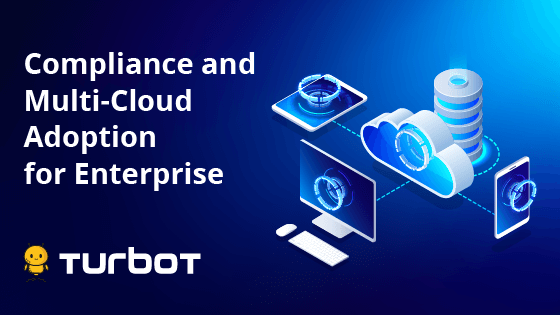Compliance and multi-cloud adoption for enterprises
You can't afford to limit your organization's access to multi-cloud environments. But freedom shouldn't put your enterprise at risk. That's why Turbot Guardrails makes it easy for Enterprise to unlock the true value of multi-cloud environments with automated security guardrails and a safe landing zone approach.

Businesses Seeking to Leverage Multiple Cloud Environments Need a Strategy that Prioritizes Security
The clear and numerous benefits of a multi-cloud strategy are why 86% of organizations desire a multi-cloud environment. It allows enterprises to use "multiple public and private clouds for different application workloads". As a result, these companies can optimize their offerings, delivering on increasing customer demands.
However, any drive towards a multi-cloud environment cannot overlook the importance of governance and security. After all, more moving parts mean that there's a greater risk for a breach. As businesses rush to take full advantage of the cloud's agility, they need a strategy for secure migration into that environment with the necessary tools to remain both safe and compliant.
What Is a Multi-Cloud Environment?
Despite the terms being used interchangeably, there is a difference between hybrid and multi-cloud environments. Hybrid is a mix of both on-premise and cloud architecture (public and/or private). Multi-cloud is a variation of hybrid that focuses on utilizing more than one cloud service provider.
A multi-cloud approach allows organizations to disperse their technological assets over a range of cloud-hosting environments (Amazon Web Services, Microsoft Azure, Google Cloud Platform, etc.). The end result is a range of added benefits for Enterprise.
Benefits of Multi-Cloud Environments for Enterprise
Increased Performance: Geographical distance can increase problems. The further users are away from your network, the more issues with latency and other problems they may experience that could worsen their experience.
Remain Compliant: As we move into an era where people are more protective of their data, Enterprises will need to be prepared to meet the regulations for governance no matter the region. With a multi-cloud environment, you can use cloud services that fulfill those requirements.
Stability: With your organization spread out over multiple clouds, you'll be able to continue functioning even if one of your service providers experiences an outage.
Application Isolation: With a multi-account strategy you can isolate applications and test them in safe and well-controlled environments. Once there, you can regulate administrative control, limit visibility and discoverability, minimize blast radius, and easily recover/audit data.
Increased Transparency/Decreased Spend: Multi-account strategies also allow you to set and monitor department spend. As a result, you can track actions across the cloud environment much easier. This prevents waste, reduces cost, and increases transparency across your organization.
Challenges of Multi-Cloud for Enterprise
Migrating into a multi-cloud environment isn't without its difficulties. There needs to be an investment in technology and training for everyone involved. There's also the question of which providers will work best for your organization. While cost is a key factor to consider, many providers have unique offerings that make them assets to certain types of enterprise.
Having more networks means an increased risk of security breaches. And while cloud service providers have a high level of security to protect their organization from outside attacks, it's often not enough. Organizations themselves are often the ones responsible for security breaches.
If your Enterprise is to remain secure over multiple systems, then there needs to be a greater emphasis placed on cloud security and governance. The optimal approach would be to deploy a system of governance that ensures compliance over multi-cloud environments through automation.
Turbot Guardrails Safe Landing Zone Approach
We recommend using a safe landing zone approach to help ensure compliance across multi-cloud environments. DevOps teams can test applications in isolated environments before exposing them to diverse cloud environments. This allows them to stay compliant and secure, helping organizations utilize the full extent of the cloud's agility.
Turbot Guardrails allow repeatable and consistent starting points for safe landing zones. Our security guardrails protect data, enable freedom, and simplify cloud capabilities for migration teams. As a result, each migration team can modify safety policies to fit their department's exact needs. Exceptions can be made as needed on a case-by-case basis, resolving the friction created by one-size-fits-all models.
Automated Guardrails Ensure Compliance
You can't afford to limit your organization's access to multi-cloud environments. But freedom shouldn't put your enterprise at risk. That's why Turbot Guardrails makes it easy for Enterprise to unlock the true value of multi-cloud environments with automated security guardrails and a safe landing zone approach.
Reach out to Turbot for a free governance assessment of your cloud infrastructure. Turbot Guardrails will analyze your cloud configurations based on best practices and set automated governance actions to correct misconfigurations.